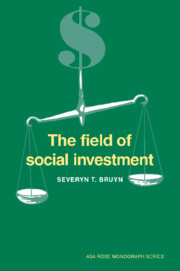Epilogue: Social investment as a self-correcting movement in the market system
Published online by Cambridge University Press: 19 January 2010
Summary
The practice of social investment is becoming more evident to the public and more organized among fiduciaries in banks, universities, cities, states, churches, mutual funds, and multinational organizations. It shows signs of increasing its momentum as more agencies become interconnected and conscious of a common cause. What appears as a trend in the 1980s may become a social movement in the 1990s.
At the same time, investment practices based solely on the profit motive have been showing a collective trend toward instability and crisis. Stock market speculation on the one hand and on the other hand debt accumulation in major institutions of the economy – corporations, banks, farms, households, and the federal government – are revealing a fault in the financial system. Sparked partly by policies of government deregulation without compensatory arrangements of self-regulation and social standards of investment, the system of finance in the United States has become overburdened with debt that can no longer be backed by real capital. Debt today rests on a very small capital base, and some economists argue that any major stress in the financial system could bring the system toward collapse.
The question is whether there may be a connection between this growing trend toward establishing social standards and self-regulation in the market system and solutions to the disastrous trend toward unregulated speculation and indebtedness. Are the new patterns of social investment developing sufficient strength and sense of direction that they may provide sensible alternatives to the purely profit-based patterns of finance now threatening the security of the national economy? Let us look briefly at each of these trends developing concurrently in the middle of the 1980s.
- Type
- Chapter
- Information
- The Field of Social Investment , pp. 222 - 255Publisher: Cambridge University PressPrint publication year: 1987



